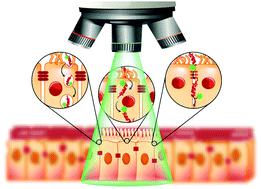当前位置:
X-MOL 学术
›
RSC Chem. Biol.
›
论文详情
Our official English website, www.x-mol.net, welcomes your
feedback! (Note: you will need to create a separate account there.)
Imaging therapeutic peptide transport across intestinal barriers
RSC Chemical Biology ( IF 4.2 ) Pub Date : 2021-6-15 , DOI: 10.1039/d1cb00024a Jannik Bruun Larsen 1 , Nayere Taebnia 1 , Alireza Dolatshahi-Pirouz 1 , Anne Zebitz Eriksen 1 , Claudia Hjørringgaard 1 , Kasper Kristensen 1 , Nanna Wichmann Larsen 1 , Niels Bent Larsen 1 , Rodolphe Marie 1 , Ann-Kathrin Mündler 1 , Ladan Parhamifar 1 , Andrew James Urquhart 1 , Arjen Weller 1 , Kim I Mortensen 1 , Henrik Flyvbjerg 1 , Thomas Lars Andresen 1
RSC Chemical Biology ( IF 4.2 ) Pub Date : 2021-6-15 , DOI: 10.1039/d1cb00024a Jannik Bruun Larsen 1 , Nayere Taebnia 1 , Alireza Dolatshahi-Pirouz 1 , Anne Zebitz Eriksen 1 , Claudia Hjørringgaard 1 , Kasper Kristensen 1 , Nanna Wichmann Larsen 1 , Niels Bent Larsen 1 , Rodolphe Marie 1 , Ann-Kathrin Mündler 1 , Ladan Parhamifar 1 , Andrew James Urquhart 1 , Arjen Weller 1 , Kim I Mortensen 1 , Henrik Flyvbjerg 1 , Thomas Lars Andresen 1
Affiliation

|
Oral delivery is a highly preferred method for drug administration due to high patient compliance. However, oral administration is intrinsically challenging for pharmacologically interesting drug classes, in particular pharmaceutical peptides, due to the biological barriers associated with the gastrointestinal tract. In this review, we start by summarizing the pharmacological performance of several clinically relevant orally administrated therapeutic peptides, highlighting their low bioavailabilities. Thus, there is a strong need to increase the transport of peptide drugs across the intestinal barrier to realize future treatment needs and further development in the field. Currently, progress is hampered by a lack of understanding of transport mechanisms that govern intestinal absorption and transport of peptide drugs, including the effects of the permeability enhancers commonly used to mediate uptake. We describe how, for the past decades, mechanistic insights have predominantly been gained using functional assays with end-point read-out capabilities, which only allow indirect study of peptide transport mechanisms. We then focus on fluorescence imaging that, on the other hand, provides opportunities to directly visualize and thus follow peptide transport at high spatiotemporal resolution. Consequently, it may provide new and detailed mechanistic understanding of the interplay between the physicochemical properties of peptides and cellular processes; an interplay that determines the efficiency of transport. We review current methodology and state of the art in the field of fluorescence imaging to study intestinal barrier transport of peptides, and provide a comprehensive overview of the imaging-compatible in vitro, ex vivo, and in vivo platforms that currently are being developed to accelerate this emerging field of research.
中文翻译:

治疗性肽跨肠道屏障转运成像
由于患者依从性高,口服给药是高度优选的给药方法。然而,由于与胃肠道相关的生物屏障,口服给药对于药理学上感兴趣的药物类别(特别是药物肽)本质上具有挑战性。在这篇综述中,我们首先总结了几种临床相关的口服治疗肽的药理学性能,强调了它们的低生物利用度。因此,迫切需要增加肽药物穿过肠屏障的转运,以实现未来的治疗需求和该领域的进一步发展。目前,由于缺乏对控制肽药物肠道吸收和转运的转运机制(包括通常用于介导吸收的通透性增强剂的作用)的了解,进展受到阻碍。我们描述了在过去的几十年中,如何主要通过具有终点读出功能的功能测定来获得机制见解,这仅允许对肽转运机制进行间接研究。然后,我们专注于荧光成像,另一方面,荧光成像提供了直接可视化的机会,从而以高时空分辨率跟踪肽转运。因此,它可以为肽的理化性质和细胞过程之间的相互作用提供新的、详细的机制理解;决定运输效率的相互作用。我们回顾了荧光成像领域当前的方法和最新技术,以研究肽的肠屏障转运,并全面概述了目前正在开发的成像兼容的体外、离体和体内平台,以加速这个新兴的研究领域。
更新日期:2021-06-23
中文翻译:

治疗性肽跨肠道屏障转运成像
由于患者依从性高,口服给药是高度优选的给药方法。然而,由于与胃肠道相关的生物屏障,口服给药对于药理学上感兴趣的药物类别(特别是药物肽)本质上具有挑战性。在这篇综述中,我们首先总结了几种临床相关的口服治疗肽的药理学性能,强调了它们的低生物利用度。因此,迫切需要增加肽药物穿过肠屏障的转运,以实现未来的治疗需求和该领域的进一步发展。目前,由于缺乏对控制肽药物肠道吸收和转运的转运机制(包括通常用于介导吸收的通透性增强剂的作用)的了解,进展受到阻碍。我们描述了在过去的几十年中,如何主要通过具有终点读出功能的功能测定来获得机制见解,这仅允许对肽转运机制进行间接研究。然后,我们专注于荧光成像,另一方面,荧光成像提供了直接可视化的机会,从而以高时空分辨率跟踪肽转运。因此,它可以为肽的理化性质和细胞过程之间的相互作用提供新的、详细的机制理解;决定运输效率的相互作用。我们回顾了荧光成像领域当前的方法和最新技术,以研究肽的肠屏障转运,并全面概述了目前正在开发的成像兼容的体外、离体和体内平台,以加速这个新兴的研究领域。











































 京公网安备 11010802027423号
京公网安备 11010802027423号